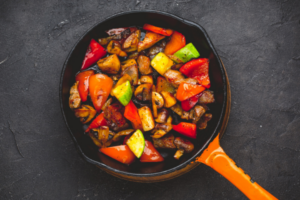The GLP-1 Revolution: When Less Food Demands More nutrient-dense Nutrition
The meteoric rise of GLP-1 receptor agonists like Ozempic, Wegovy, and Mounjaro has sparked a significant shift in consumption patterns across America. Originally developed for diabetes management, these medications have gained widespread popularity for their effectiveness in weight management, with approximately 7 million Americans now using these treatments.
The core mechanism behind these medications—appetite suppression and delayed gastric emptying—creates both challenges and opportunities for the food industry. While these medications help people consume less food overall, they simultaneously create a pressing need to maximize the nutritional value of every bite. This new paradigm presents a unique opportunity for food manufacturers to innovate with nutrient-dense additions that transform smaller servings into nutritional powerhouses.
The Nutritional Challenge of Reduced Intake
For individuals taking GLP-1 medications, maintaining adequate nutrition while consuming smaller portions presents a significant challenge. Research published in the Journal of Clinical Endocrinology & Metabolism indicates that without careful attention to nutrient density, GLP-1 users may experience deficiencies in:
- Essential vitamins, particularly fat-soluble vitamins A, D, E, and K
- Critical minerals including iron, calcium, and magnesium
- High-quality protein necessary for muscle maintenance
- Omega-3 fatty acids and other essential fats
The food industry now faces the challenge—and opportunity—to develop solutions that address these specific concerns while catering to consumers who are increasingly knowledgeable about nutrition and mindful of portion sizes.
Superfood Powders: Nutrient-Dense Nutrition in Minimal Volume
Superfood powders represent one of the most versatile and effective nutrient-dense additions for the GLP-1 market. These concentrated powders offer an exceptional nutrient-to-volume ratio, making them ideal for consumers seeking maximum nutrition in minimal portions.
Key players in the superfood powder space include:
- Spirulina and chlorella: These blue-green algae provide complete protein with all essential amino acids while requiring just a teaspoon to deliver significant nutritional benefits.
- Moringa powder: With more calcium than milk, more vitamin C than oranges, and more potassium than bananas, moringa exemplifies the concept of nutrient density.
- Cacao powder: Rich in magnesium, iron, and antioxidants, cacao offers both nutritional and satiety benefits.
Food manufacturers integrating these superfood powders into formulations can significantly enhance the nutritional profile of products without increasing volume—a perfect alignment with the needs of GLP-1 users.


Fortified Micronutrient Blends: Precision Nutrient-Dense Nutrition
The development of customized micronutrient blends represents another innovative approach to addressing the specific nutritional needs of GLP-1 medication users. Unlike traditional fortification approaches, these specialized blends are designed with precise ratios of vitamins and minerals that:
- Compensate for reduced food volume
- Support metabolic health
- Maintain energy levels
- Promote satiety despite smaller portions
Forward-thinking food manufacturers are now incorporating these fortified blends into everything from protein bars to ready-to-drink beverages, creating products that deliver complete nutrition in compact servings. The key advantage of these blends is their ability to be formulated precisely to address the specific nutritional gaps common among GLP-1 users.
Omega-3 and Essential Fatty Acid Additions: Quality Fats in Small Packages
Despite their caloric density, essential fatty acids—particularly omega-3s—remain critical nutrients that cannot be sacrificed even in reduced-calorie diets. Innovations in this space include:
- Microencapsulated fish oil that eliminates unpleasant tastes while preserving nutritional benefits
- Algae-derived DHA and EPA that provide plant-based alternatives
- Structured lipids that optimize absorption in smaller doses
These advanced fat delivery systems allow manufacturers to include critical fatty acids in products without significantly increasing serving size or compromising taste—crucial considerations for the GLP-1 consumer.
Meeting Consumer Demands: Quality Over Quantity
The shift toward nutrient-dense additions aligns perfectly with broader consumer trends toward mindful consumption. Modern consumers increasingly prioritize functional benefits over volume, seeking foods that deliver maximum nutritional value regardless of portion size.
Market research by Mintel indicates that 67% of consumers now consider nutrient density when making food purchases, with this figure rising to 82% among those actively managing their weight. This represents a significant shift from previous decades when value was often associated with larger portions.
For food manufacturers, this shift presents an opportunity to develop premium products that emphasize quality over quantity—positioning that resonates strongly with both GLP-1 users and health-conscious consumers more broadly.
The Future of Nutrient-Dense Innovation
As the prevalence of GLP-1 medications continues to grow, we can expect to see further innovation in nutrient-dense additions. Emerging technologies that show particular promise include:
- Bioactive peptides that enhance nutrient absorption
- Prebiotic fiber blends that support gut health while adding minimal volume
- Fermented ingredients that increase bioavailability of existing nutrients
These innovations will continue to transform the food landscape, creating products that efficiently deliver comprehensive nutrition despite reduced overall food intake.
Conclusion: Transforming Challenges into Opportunities
The rise of GLP-1 medications represents not a crisis for the food industry but rather an opportunity to reimagine food formulation with a focus on nutrient density rather than volume. By embracing superfood powders, fortified micronutrient blends, and advanced essential fatty acid delivery systems, manufacturers can develop products that perfectly align with the needs of today’s consumers.
In this new paradigm, success belongs to companies such as St. Charles Trading that understand how to transform small servings into nutrient powerhouses—meeting consumer demands for quality over quantity while supporting optimal health outcomes for GLP-1 users and health-conscious consumers alike.



